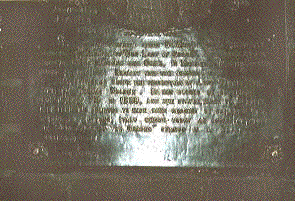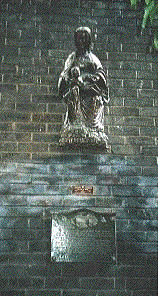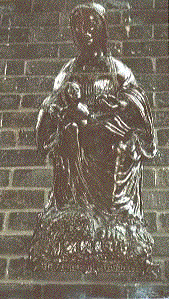
And then the main commemorative plaque
'Arms of the Borough of Ipswich England (under crest)
On this site formerly stood St Mary's Chapel commonly called The Chapel Of "Our Lady Of Grace" containing an oak statue of the Madonna and Child. In medieval times pilgrimages made to it included Royalty and the famous.
Later it came under the protection of The Lord Chancellor, Cardinal Thomas Wolsey. It was closed by order of King Henry VIII in 1538 and the statue, taken to London for burning, is believed to have been rescued by sailors and taken to Nettuno, Italy where today an ancient statue of "Our Lady Of The Graces" stands in a major shrine church.
Copyright
1989 Robt. N. Mellamphy'
[We hope that the sculptor and Meryemana don't mind us breaking their copyright in reproducing this text; after all this wouldn't be much of an historic lettering website without it, would it?]

The shrine to Our Lady of Grace was recently restored in the nearby (Anglo-Catholic) St Mary at Elms church in Elm Street. The replica statue is, again, by Ipswich carver Robert Malamphy, and it was dedicated with great ecumenical ceremony in September 2002. The image is a copy of the one at Nettuno in Italy, which many people believe to be the rescued statue of Our Lady of Ipswich. If this is true, one can only imagine the journey; condemned to being burnt by reformers, rescued by Catholic adherents and smuggled from London to be shipped to the west coast of Italy. The only shame is that, nestling in its niche, one is unable to see the small characters from Ipswich history which - we are told - the artist has carved on the back of the figure.
This photograph was taken during the first Ip-art festival in 2003; St Mary at Elms and its surrounding ancient cottages (a gateway to the north of the tower takes you through to the St Mary Elms cottage of the 1470s: the oldest inhabited building in Ipswich!), churchyard and public sculpture are well worth a visit; a taste of Walsingham in Ipswich with very ancient parts of the building such as the 11th century Norman doorway still in use. Simon Knott's Suffolk Churches website gives further insights and is listed on our Links page.
 -
-
